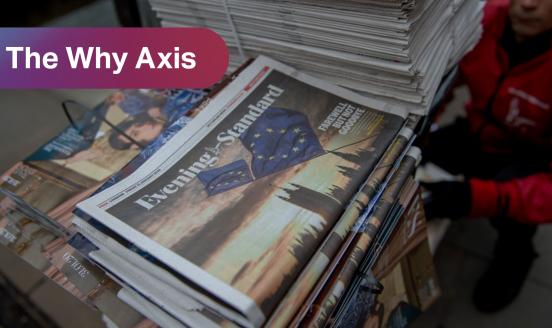Fast and furious: how digital bank runs challenge the banking-crisis rulebook
The speed of recent bank failures has shown the need for more systemic protection of the financial system.

For those hoping that 2023 would bring some respite after the pandemic and war in Ukraine, there has been a rude awakening. Pressured by the fastest monetary tightening on record, some corners of the financial system have cracked. A stream of crypto bankruptcies led ultimately to the demise of crypto-involved Signature Bank of New York (SBNY). Then, in what has been labelled a “Lehman moment for technology”, came the collapse of Silicon Valley Bank (SVB), lender to startups and their venture capital backers. Tensions spilled over to Europe and claimed Credit Suisse, killed, according to its Chairman, by a social media storm.
These bank failures had major differences. But they also share two common traits that raise far-reaching questions.
The first is the speed at which the crises unfolded. SVB announced a plan to raise capital on Wednesday 8 March, but was put into receivership on Friday 10 March. SBNY failed two days later. It took just one day, after incautious comments from its largest shareholder, for Credit Suisse to announce it would take a CHF 50 billion loan from the Swiss central bank.
In a world in which depositors handle both money and information digitally, bank rushes have replaced bank runs. In 2019, Bundesbank President Jens Weidmann argued that digital bank runs could threaten financial stability because they happen quicker and more extensively. He was speaking about the theoretical case of a ‘flight to safety’ towards a central bank digital currency, but the same applies to deposits moving digitally within the banking system.
Social media reinforces the risks. In the midst of the SVB collapse, finance influencers sent panicky tweets that may attract further regulatory scrutiny once the dust has settled. Financial misinformation via social media has proved before to be a powerful crisis engine: in 2011, an unfounded Twitter rumour triggered a bank run on Swedbank and SEB. In 2019, false information in a WhatsApp post led to a run on Metro Bank in the United Kingdom. Credit Suisse itself was taken on by the Reddit crowds in late 2022. Now is the first time, however, that the phenomenon shows potential for systemic effects.
Over-hasty decisions
This leads to the second common aspect of these crises. Because they had to be dealt with in such haste, authorities took problematic decisions with potentially long-term policy consequences.
In an apparent bid to prevent a severe downturn in the startup ecosystem, US authorities said they would guarantee all deposits at SVB and SBNY, about 90% of which were uninsured. Though applicable only to the two failed banks, in practice the decision creates an expectation that all deposits will be treated equally. And in fact US authorities have reportedly started studying ways to protect all deposits in case of a worsening of the crisis. Federal regulators have painted themselves into a corner: once the expectation becomes embedded, reversing it could trigger new panic.
While US authorities were busy subverting the theory of incentives behind deposit insurance, the Swiss Financial Market Supervisory Authority (FINMA) revisited some equally long-held truths about the seniority of creditors. As part of the sale of Credit Suisse to UBS, FINMA decided to write off $17 billion of bonds issued by Credit Suisse without having previously written off shareholders, which are junior to bondholders in banks’ capital structures. The decision triggered a negative reaction in financial markets and prompted European Union and UK regulators to distance themselves from the Swiss approach.
Like the US decision to insure all depositors, FINMA’s decision to disrupt the hierarchy of claims creates new problematic expectations. Debt securities issued by Swiss banks may be regarded differently than in other jurisdictions, and raising funds to meet liquidity and capital requirements may become more difficult and expensive. FINMA’s decision also implies that emergency liquidity provision may be enough for authorities to activate resolution-style bail-in, even if the bank is not declared to be failing or likely to fail (which Credit Suisse never was). Conflating the two concepts of illiquidity and insolvency may limit the effectiveness of the central bank’s lender-of-last-resort function in preventing one situation from turning into the other.
Grasping lightening
The Swiss approach is unlikely to find acolytes outside Switzerland, but it does raise the question of what can be done to handle banks that face lightening-speed deterioration in liquidity without losses or apparent solvency issues. The rules underpinning banks’ liquidity requirements need to be rethought. Liquidity coverage ratios (LCR) are calculated assuming banks need to hold sufficient high-quality liquid assets to withstand outflows of 3%+ of stable deposits and 10%+ less-stable retail funds over 30 days. But SVB reportedly experienced $42 billion of withdrawals – a quarter of its uninsured deposits – in just 24 hours. Withdrawals at Signature were $18 billion in one day, 20% of its deposit base. Credit Suisse saw outflows of $56 billion in October 2022, 20% of deposits. Supervisors should also monitor closely any suspicious concentration risk in banks’ deposit bases.
Conservative assumptions in the LCR calculations would afford more time to deal with rapid banking crises. But no higher LCR ratio can realistically save a bank from outflows of the scale seen by SVB or Signature Bank. The only way to mitigate this kind of financial stability risk is to ensure confidence in the system is not lost in the first place.
EU authorities are reportedly discussing equal protection of deposits below and above the insurance threshold in case of resolution and sale of business. This would raise the same concerns as what has happened in the US. A less distortionary and more effective option for the EU would be to dust off the long-dormant EU Deposit Insurance Scheme and – moving beyond non-committal statements of the type issued by euro-area finance ministers on 24 March – finally agree to complete EU banking union.
* Disclosure of interest: In addition to her Bruegel role, Silvia Merler is Head of ESG and Policy Research at asset manager Algebris Investments.



